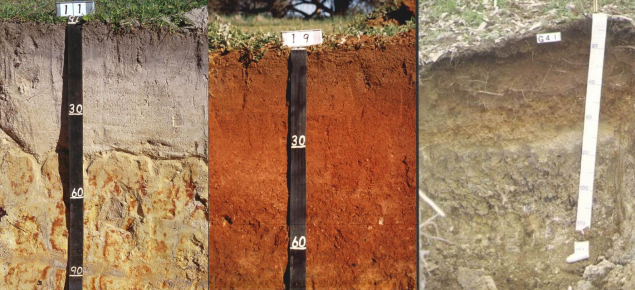One of my major research interests is the coevolution of soils, landforms, and biota. I’ve been working in this area pretty steadily since about 2000, but until 2013 I was completely unaware of some work being done along the same lines, over about the same time period. This is the work of W.H. Verboom and J.S. Pate from Western Australia, who among other things developed the “phytotarium concept.” Phytotarium defines the specific plants and microbial associates driving specific pedological changes during niche construction. This concept, and a wealth of work on biogenic origins of pedological and geomorphological features such as clay pavements, texture-contrast (duplex, as they call them in Australia) soils, and laterites, was highly relevant to my own thinking (e.g., Phillips, 2009a; 2009b), but though I consider myself familiar with the biogeomorphology and pedogenesis literature, then and now, I had somehow missed it.

Deep sandy duplex (vertical texture contrast) soils, Western Australia. Photo credit: Dept. of Agriculture & Food, Western Australia.
I finally became aware of their work when they synthesized it in an article in Geoderma (Verboom & Pate, 2013), a key soil science journal that I follow (I am actually on the editorial board). I immediately contacted Verboom, apologized for not citing their work, and asked for reprints of the earlier stuff, which he sent at once. As it turns out, they were also until then unaware of my publications.
The reason—publication venues. Pate and Verboom published their earlier work (see references below) on phytotaria and bioengineering of soils in journals I do not normally read, such as Plant & Soil and Annals of Botany. These are solid, well-respected journals, and at least as valid a place to publish this sort of work as Geoderma and American Journal of Science (which despite the name is an Earth sciences journal), where my articles were printed. While I follow some of the ecology and biogeography journals as well as the geosciences literature, I cannot keep up with them all, and certainly not botanical publications, too.
So what’s the message or lesson here, other than that you should check out Verboom and Pate’s work, which is outstanding? I’m not sure. I could reiterate some standard homilies about the need to read and think broadly and outside one’s subdiscipline, which are true enough. However, being a pedologist, geomorphologist, or soil biologist already entails roaming a pretty broad transdisciplinary territory. I doubt soil biologists or botanists have any time to read geomorphology journals, any more than I have time to follow their venues. Search tools and databases help a lot, but in some cases, such as this one, we did not happen to use keywords that turned up each others’ work. But I also don’t feel I should leave this as “just one of those things.” So, homilies aside, I suppose we should all remain aware that there may be, and probably are, relevant ideas being floated outside our specialties. No matter how diligent we are, given our finite time and the ever-expanding scientific corpus, our normal search patterns are not going to detect it all. Thus we should be thankful rather than annoyed when reviewers point out things we missed, and for serendipitous discoveries, such as when I happened on Verboom and Pate (2013). Second, we should perhaps pay more attention to the keywords we submit with our papers to increase the likelihood that our work falls into the hands of those outside our specialty groups.
References
Pate JS, Verboom WH. 2009. Contemporary biogenic formation of clay pavements by eucalypts: further support of the phytotarium concept. Annals of Botany 103: 673-685.
Pate JS, Verboom WH, Galloway PG. 2001. Co-occurrence of Proteaceae, laterite, and related oligotrophic soils: coincidental associations or causative inter-relationships? Australian Journal of Botany 49: 529-560.
Phillips JD. 2009a. Biological energy in landscape evolution. American Journal of Science 309: 271-290.
Phillips JD. 2009. Soils as extended composite phenotypes. Geoderma 149: 143-151.
Verboom WH, Pate JS. 2003. Relationships between cluster root-bearing taxa and laterite across landscapes in southwest Western Australia: an approach using airborne radiometric and digital elevation models. Plant and Soil 248: 321-333.
Verboom WH, Pate JS. 2006. Bioengineering of soil profiles in semiarid ecosystems: the ‘phytotarium’ concept. A review. Plant and Soil 289: 71-102.
Verboom WH, Pate JS. 2013. Exploring the biological dimensions to pedogenesis with emphasis on the ecosystems, soils, and landscapes of southwestern Australia. Geoderma 211-2: 154-183.
Verboom WH, Pate JS, Aspandiar M. 2009. Neoformation of clay in lateral root catchments of mallee eucalypts: a chemical perspective. Annals of Botany 105: 23-36.
